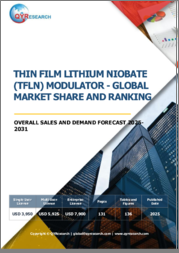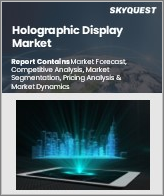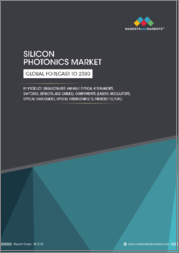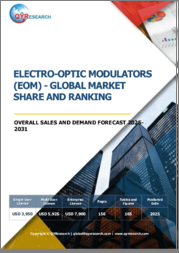
|
시장보고서
상품코드
1770895
니오브산 리튬 시장 - 세계 산업 규모, 점유율, 동향, 기회, 예측 : 제품 유형별, 결정 유형별, 용도별, 지역별, 경쟁별(2020-2030년)Lithium Niobate Market - Global Industry Size, Share, Trends, Opportunity, and Forecast, Segmented By Product Type, By Crystal Type, By Application, By Region & Competition, 2020-2030F |
||||||
니오브산 리튬 세계 시장 규모는 2024년에 47억 4,000만 달러, 2030년에는 72억 2,000만 달러에 달하고, 예측 기간 동안 CAGR 7.10%로 확대될 것으로 예측됩니다.
이 시장은 통신, 포토닉스, 가전, 국방 등 고성능 애플리케이션에서 니오브산 리튬이 필수적인 역할을 담당하고 있기 때문에 꾸준히 성장하고 있습니다. 전기광학, 압전, 비선형 광학 특성으로 유명한 니오브산 리튬은 광 변조기, SAW 필터, 공진기, 광 집적 회로 및 기타 장치에 널리 사용되고 있으며, 5G, 광섬유 네트워크 및 고속 데이터 시스템의 채택이 증가함에 따라 니오브산 리튬 기반 부품에 대한 수요가 증가하고 있습니다. 이와 함께 박막 니오브산 리튬(TFLN) 및 니오브산 리튬 온 인슐레이터(LNOI) 플랫폼의 개발로 소자의 소형화 및 에너지 효율적인 광집적화가 가능해졌습니다. 이러한 발전은 차세대 통신 및 양자 포토닉스에 있어 매우 중요합니다. 또한, 니오브산 리튬은 내구성과 열 안정성으로 인해 항공우주 및 국방 분야의 첨단 센싱 및 고주파 응용 분야에서 중요한 재료로 자리매김하고 있으며, 여러 산업 분야에서 장기적인 전략적 연관성을 보장하고 있습니다.
| 시장 개요 | |
|---|---|
| 예측 기간 | 2026-2030년 |
| 시장 규모 : 2024년 | 47억 4,000만 달러 |
| 시장 규모 : 2030년 | 72억 2,000만 달러 |
| CAGR : 2025-2030년 | 7.10% |
| 급성장 부문 | 음향 등급 니오브산 리튬 |
| 최대 시장 | 북미 |
시장 촉진요인
5G와 통신 인프라 보급
주요 시장 과제
높은 제조 비용과 재료비
주요 시장 동향
양자 포토닉스에서 니오브산 리튬의 통합 확대
목차
제1장 개요
제2장 조사 방법
제3장 주요 요약
제4장 고객의 소리
제5장 세계의 니오브산 리튬 시장 전망
- 시장 규모 및 예측
- 금액별
- 시장 점유율과 예측
- 제품 유형별(광학 등급 니오브산 리튬, 음향 등급 니오브산 리튬)
- 결정 유형별(Z컷 니오브산 리튬, X컷 니오브산 리튬, Y컷 니오브산 리튬, 기타)
- 용도별(통신, 가전제품, 방위·항공우주, 헬스케어, 기타)
- 지역별(북미, 유럽, 남미, 중동 및 아프리카, 아시아태평양)
- 기업별(2024)
- 시장 맵
제6장 북미의 니오브산 리튬 시장 전망
- 시장 규모 및 예측
- 시장 점유율과 예측
- 북미 : 국가별 분석
- 미국
- 캐나다
- 멕시코
제7장 유럽의 니오브산 리튬 시장 전망
- 시장 규모 및 예측
- 시장 점유율과 예측
- 유럽 : 국가별 분석
- 독일
- 프랑스
- 영국
- 이탈리아
- 스페인
제8장 아시아태평양의 니오브산 리튬 시장 전망
- 시장 규모 및 예측
- 시장 점유율과 예측
- 아시아태평양 : 국가별 분석
- 중국
- 인도
- 일본
- 한국
- 호주
제9장 중동 및 아프리카의 니오브산 리튬 시장 전망
- 시장 규모 및 예측
- 시장 점유율과 예측
- 중동 및 아프리카 : 국가별 분석
- 사우디아라비아
- 아랍에미리트
- 남아프리카공화국
제10장 남미의 니오브산 리튬 시장 전망
- 시장 규모 및 예측
- 시장 점유율과 예측
- 남미 : 국가별 분석
- 브라질
- 콜롬비아
- 아르헨티나
제11장 시장 역학
- 성장 촉진요인
- 과제
제12장 시장 동향과 발전
- 인수합병
- 제품 출시
- 최근 동향
제13장 기업 개요
- Sumitomo Metal Mining Co. Ltd.
- Shin Etsu Chemical Co. Ltd.
- Crystal Technology, Inc.
- Korth Kristalle GmbH
- EKSMA Optics
- Oxide Corporation
- Raicol Crystals Ltd.
- United Crystals, Inc.
- Coherent Corp.
- Fujitsu Optical Components
제14장 전략적 제안
제15장 조사 회사 소개 및 면책사항
ksm 25.07.18The Global Lithium Niobate Market was valued at USD 4.74 Billion in 2024 and is projected to reach USD 7.22 Billion by 2030, expanding at a CAGR of 7.10% during the forecast period. The market is witnessing steady growth due to lithium niobate's essential role in high-performance applications across telecommunications, photonics, consumer electronics, and defense. Renowned for its electro-optic, piezoelectric, and nonlinear optical properties, lithium niobate is widely used in devices such as optical modulators, SAW filters, resonators, and photonic integrated circuits. Rising adoption of 5G, fiber-optic networks, and high-speed data systems is fueling demand for lithium niobate-based components. In parallel, the development of thin-film lithium niobate (TFLN) and lithium-niobate-on-insulator (LNOI) platforms is enabling device miniaturization and energy-efficient photonic integration. These advancements are crucial for next-generation telecom and quantum photonics. Moreover, its durability and thermal stability position lithium niobate as a key material for advanced sensing and high-frequency applications in aerospace and defense, ensuring long-term strategic relevance across multiple industries.
| Market Overview | |
|---|---|
| Forecast Period | 2026-2030 |
| Market Size 2024 | USD 4.74 Billion |
| Market Size 2030 | USD 7.22 Billion |
| CAGR 2025-2030 | 7.10% |
| Fastest Growing Segment | Acoustic Grade Lithium Niobate |
| Largest Market | North America |
Key Market Drivers
Proliferation of 5G and Telecom Infrastructure
The accelerated deployment of 5G infrastructure is significantly boosting the demand for lithium niobate-based optical modulators, vital for high-speed data transmission. As of 2023, more than 3.7 million 5G base stations have been installed globally, with Asia adding approximately 250,000 new stations each quarter. Optical transceivers operating at 200G and 400G speeds, heavily deployed in urban networks, rely on lithium niobate modulators in nearly 80% of cases. More than 60% of next-generation fiber backhaul systems utilize electro-optic devices made from lithium niobate. With over USD 270 billion invested globally in telecom upgrades, operators prioritize optical components that deliver high speed with minimal insertion loss-typically below 3 dB, a performance level that lithium niobate consistently achieves. These capabilities are driving its adoption as the material of choice in advanced 5G communication systems.
Key Market Challenges
High Manufacturing and Material Costs
The lithium niobate market faces notable cost challenges linked to the material's complex and resource-intensive production processes. High-purity crystals are grown using the Czochralski method, requiring precision equipment and significant energy input. The cost of key raw materials-lithium and niobium oxides-has escalated due to global supply chain pressures, pushing up production costs. Processing steps like wafer slicing, polishing, and nanofabrication demand specialized tools and expertise, further raising expenses. Transitioning to thin-film lithium niobate (TFLN) adds complexity, as it involves bonding and etching procedures that increase manufacturing overhead. Startups and smaller companies often struggle with these barriers due to limited capital and lower production volumes. In addition, the niche nature of lithium niobate reduces economies of scale compared to silicon-based platforms. These cost-related obstacles hinder adoption in budget-sensitive sectors like automotive and consumer electronics, pressuring suppliers to balance performance with affordability and sustain R&D investment despite margin constraints.
Key Market Trends
Growing Integration of Lithium Niobate in Quantum Photonics
The application of lithium niobate in quantum photonics is expanding rapidly due to its outstanding electro-optic and nonlinear optical characteristics, which are crucial for manipulating quantum light. It is being widely used in quantum communication, computing, and sensing technologies-particularly for generating entangled photons, performing modulation in QKD systems, and integrating optical functions onto quantum photonic circuits (QPICs). Institutions and startups across North America, Europe, and Asia are incorporating lithium niobate into chip-based quantum devices, with thin-film lithium niobate enabling high integration density and single-photon-level precision. National quantum strategies are also allocating funding to support lithium niobate research and commercialization, fostering collaborations among academic institutions, photonic foundries, and defense organizations. As demand grows for secure quantum networks and post-quantum encryption systems, lithium niobate's broadband transparency, thermal resilience, and scalability solidify its role as a foundational material in the evolving quantum technology ecosystem.
Key Market Players
- Sumitomo Metal Mining Co. Ltd.
- Shin Etsu Chemical Co. Ltd.
- Crystal Technology, Inc.
- Korth Kristalle GmbH
- EKSMA Optics
- Oxide Corporation
- Raicol Crystals Ltd.
- United Crystals, Inc.
- Coherent Corp.
- Fujitsu Optical Components
Report Scope:
In this report, the Global Lithium Niobate Market has been segmented into the following categories, in addition to the industry trends which have also been detailed below:
Lithium Niobate Market, By Product Type:
- Optical Grade Lithium Niobate
- Acoustic Grade Lithium Niobate
Lithium Niobate Market, By Crystal Type:
- Z-cut Lithium Niobate
- X-cut Lithium Niobate
- Y-cut Lithium Niobate
- Others
Lithium Niobate Market, By Application:
- Telecommunication
- Consumer Electronics
- Defense & Aerospace
- Healthcare
- Others
Lithium Niobate Market, By Region:
- North America
- United States
- Canada
- Mexico
- Europe
- Germany
- France
- United Kingdom
- Italy
- Spain
- South America
- Brazil
- Argentina
- Colombia
- Asia-Pacific
- China
- India
- Japan
- South Korea
- Australia
- Middle East & Africa
- Saudi Arabia
- UAE
- South Africa
Competitive Landscape
Company Profiles: Detailed analysis of the major companies present in the Global Lithium Niobate Market.
Available Customizations:
Global Lithium Niobate Market report with the given market data, TechSci Research offers customizations according to a company's specific needs. The following customization options are available for the report:
Company Information
- Detailed analysis and profiling of additional market players (up to five).
Table of Contents
1. Product Overview
- 1.1. Market Definition
- 1.2. Scope of the Market
- 1.2.1. Markets Covered
- 1.2.2. Years Considered for Study
- 1.2.3. Key Market Segmentations
2. Research Methodology
- 2.1. Objective of the Study
- 2.2. Baseline Methodology
- 2.3. Key Industry Partners
- 2.4. Major Association and Secondary Sources
- 2.5. Forecasting Methodology
- 2.6. Data Triangulation & Validation
- 2.7. Assumptions and Limitations
3. Executive Summary
- 3.1. Overview of the Market
- 3.2. Overview of Key Market Segmentations
- 3.3. Overview of Key Market Players
- 3.4. Overview of Key Regions/Countries
- 3.5. Overview of Market Drivers, Challenges, and Trends
4. Voice of Customer
5. Global Lithium Niobate Market Outlook
- 5.1. Market Size & Forecast
- 5.1.1. By Value
- 5.2. Market Share & Forecast
- 5.2.1. By Product Type (Optical Grade Lithium Niobate, Acoustic Grade Lithium Niobate)
- 5.2.2. By Crystal Type (Z-cut Lithium Niobate, X-cut Lithium Niobate, Y-cut Lithium Niobate, Others)
- 5.2.3. By Application (Telecommunication, Consumer Electronics, Defense & Aerospace, Healthcare, Others)
- 5.2.4. By Region (North America, Europe, South America, Middle East & Africa, Asia Pacific)
- 5.3. By Company (2024)
- 5.4. Market Map
6. North America Lithium Niobate Market Outlook
- 6.1. Market Size & Forecast
- 6.1.1. By Value
- 6.2. Market Share & Forecast
- 6.2.1. By Product Type
- 6.2.2. By Crystal Type
- 6.2.3. By Application
- 6.2.4. By Country
- 6.3. North America: Country Analysis
- 6.3.1. United States Lithium Niobate Market Outlook
- 6.3.1.1. Market Size & Forecast
- 6.3.1.1.1. By Value
- 6.3.1.2. Market Share & Forecast
- 6.3.1.2.1. By Product Type
- 6.3.1.2.2. By Crystal Type
- 6.3.1.2.3. By Application
- 6.3.1.1. Market Size & Forecast
- 6.3.2. Canada Lithium Niobate Market Outlook
- 6.3.2.1. Market Size & Forecast
- 6.3.2.1.1. By Value
- 6.3.2.2. Market Share & Forecast
- 6.3.2.2.1. By Product Type
- 6.3.2.2.2. By Crystal Type
- 6.3.2.2.3. By Application
- 6.3.2.1. Market Size & Forecast
- 6.3.3. Mexico Lithium Niobate Market Outlook
- 6.3.3.1. Market Size & Forecast
- 6.3.3.1.1. By Value
- 6.3.3.2. Market Share & Forecast
- 6.3.3.2.1. By Product Type
- 6.3.3.2.2. By Crystal Type
- 6.3.3.2.3. By Application
- 6.3.3.1. Market Size & Forecast
- 6.3.1. United States Lithium Niobate Market Outlook
7. Europe Lithium Niobate Market Outlook
- 7.1. Market Size & Forecast
- 7.1.1. By Value
- 7.2. Market Share & Forecast
- 7.2.1. By Product Type
- 7.2.2. By Crystal Type
- 7.2.3. By Application
- 7.2.4. By Country
- 7.3. Europe: Country Analysis
- 7.3.1. Germany Lithium Niobate Market Outlook
- 7.3.1.1. Market Size & Forecast
- 7.3.1.1.1. By Value
- 7.3.1.2. Market Share & Forecast
- 7.3.1.2.1. By Product Type
- 7.3.1.2.2. By Crystal Type
- 7.3.1.2.3. By Application
- 7.3.1.1. Market Size & Forecast
- 7.3.2. France Lithium Niobate Market Outlook
- 7.3.2.1. Market Size & Forecast
- 7.3.2.1.1. By Value
- 7.3.2.2. Market Share & Forecast
- 7.3.2.2.1. By Product Type
- 7.3.2.2.2. By Crystal Type
- 7.3.2.2.3. By Application
- 7.3.2.1. Market Size & Forecast
- 7.3.3. United Kingdom Lithium Niobate Market Outlook
- 7.3.3.1. Market Size & Forecast
- 7.3.3.1.1. By Value
- 7.3.3.2. Market Share & Forecast
- 7.3.3.2.1. By Product Type
- 7.3.3.2.2. By Crystal Type
- 7.3.3.2.3. By Application
- 7.3.3.1. Market Size & Forecast
- 7.3.4. Italy Lithium Niobate Market Outlook
- 7.3.4.1. Market Size & Forecast
- 7.3.4.1.1. By Value
- 7.3.4.2. Market Share & Forecast
- 7.3.4.2.1. By Product Type
- 7.3.4.2.2. By Crystal Type
- 7.3.4.2.3. By Application
- 7.3.4.1. Market Size & Forecast
- 7.3.5. Spain Lithium Niobate Market Outlook
- 7.3.5.1. Market Size & Forecast
- 7.3.5.1.1. By Value
- 7.3.5.2. Market Share & Forecast
- 7.3.5.2.1. By Product Type
- 7.3.5.2.2. By Crystal Type
- 7.3.5.2.3. By Application
- 7.3.5.1. Market Size & Forecast
- 7.3.1. Germany Lithium Niobate Market Outlook
8. Asia Pacific Lithium Niobate Market Outlook
- 8.1. Market Size & Forecast
- 8.1.1. By Value
- 8.2. Market Share & Forecast
- 8.2.1. By Product Type
- 8.2.2. By Crystal Type
- 8.2.3. By Application
- 8.2.4. By Country
- 8.3. Asia Pacific: Country Analysis
- 8.3.1. China Lithium Niobate Market Outlook
- 8.3.1.1. Market Size & Forecast
- 8.3.1.1.1. By Value
- 8.3.1.2. Market Share & Forecast
- 8.3.1.2.1. By Product Type
- 8.3.1.2.2. By Crystal Type
- 8.3.1.2.3. By Application
- 8.3.1.1. Market Size & Forecast
- 8.3.2. India Lithium Niobate Market Outlook
- 8.3.2.1. Market Size & Forecast
- 8.3.2.1.1. By Value
- 8.3.2.2. Market Share & Forecast
- 8.3.2.2.1. By Product Type
- 8.3.2.2.2. By Crystal Type
- 8.3.2.2.3. By Application
- 8.3.2.1. Market Size & Forecast
- 8.3.3. Japan Lithium Niobate Market Outlook
- 8.3.3.1. Market Size & Forecast
- 8.3.3.1.1. By Value
- 8.3.3.2. Market Share & Forecast
- 8.3.3.2.1. By Product Type
- 8.3.3.2.2. By Crystal Type
- 8.3.3.2.3. By Application
- 8.3.3.1. Market Size & Forecast
- 8.3.4. South Korea Lithium Niobate Market Outlook
- 8.3.4.1. Market Size & Forecast
- 8.3.4.1.1. By Value
- 8.3.4.2. Market Share & Forecast
- 8.3.4.2.1. By Product Type
- 8.3.4.2.2. By Crystal Type
- 8.3.4.2.3. By Application
- 8.3.4.1. Market Size & Forecast
- 8.3.5. Australia Lithium Niobate Market Outlook
- 8.3.5.1. Market Size & Forecast
- 8.3.5.1.1. By Value
- 8.3.5.2. Market Share & Forecast
- 8.3.5.2.1. By Product Type
- 8.3.5.2.2. By Crystal Type
- 8.3.5.2.3. By Application
- 8.3.5.1. Market Size & Forecast
- 8.3.1. China Lithium Niobate Market Outlook
9. Middle East & Africa Lithium Niobate Market Outlook
- 9.1. Market Size & Forecast
- 9.1.1. By Value
- 9.2. Market Share & Forecast
- 9.2.1. By Product Type
- 9.2.2. By Crystal Type
- 9.2.3. By Application
- 9.2.4. By Country
- 9.3. Middle East & Africa: Country Analysis
- 9.3.1. Saudi Arabia Lithium Niobate Market Outlook
- 9.3.1.1. Market Size & Forecast
- 9.3.1.1.1. By Value
- 9.3.1.2. Market Share & Forecast
- 9.3.1.2.1. By Product Type
- 9.3.1.2.2. By Crystal Type
- 9.3.1.2.3. By Application
- 9.3.1.1. Market Size & Forecast
- 9.3.2. UAE Lithium Niobate Market Outlook
- 9.3.2.1. Market Size & Forecast
- 9.3.2.1.1. By Value
- 9.3.2.2. Market Share & Forecast
- 9.3.2.2.1. By Product Type
- 9.3.2.2.2. By Crystal Type
- 9.3.2.2.3. By Application
- 9.3.2.1. Market Size & Forecast
- 9.3.3. South Africa Lithium Niobate Market Outlook
- 9.3.3.1. Market Size & Forecast
- 9.3.3.1.1. By Value
- 9.3.3.2. Market Share & Forecast
- 9.3.3.2.1. By Product Type
- 9.3.3.2.2. By Crystal Type
- 9.3.3.2.3. By Application
- 9.3.3.1. Market Size & Forecast
- 9.3.1. Saudi Arabia Lithium Niobate Market Outlook
10. South America Lithium Niobate Market Outlook
- 10.1. Market Size & Forecast
- 10.1.1. By Value
- 10.2. Market Share & Forecast
- 10.2.1. By Product Type
- 10.2.2. By Crystal Type
- 10.2.3. By Application
- 10.2.4. By Country
- 10.3. South America: Country Analysis
- 10.3.1. Brazil Lithium Niobate Market Outlook
- 10.3.1.1. Market Size & Forecast
- 10.3.1.1.1. By Value
- 10.3.1.2. Market Share & Forecast
- 10.3.1.2.1. By Product Type
- 10.3.1.2.2. By Crystal Type
- 10.3.1.2.3. By Application
- 10.3.1.1. Market Size & Forecast
- 10.3.2. Colombia Lithium Niobate Market Outlook
- 10.3.2.1. Market Size & Forecast
- 10.3.2.1.1. By Value
- 10.3.2.2. Market Share & Forecast
- 10.3.2.2.1. By Product Type
- 10.3.2.2.2. By Crystal Type
- 10.3.2.2.3. By Application
- 10.3.2.1. Market Size & Forecast
- 10.3.3. Argentina Lithium Niobate Market Outlook
- 10.3.3.1. Market Size & Forecast
- 10.3.3.1.1. By Value
- 10.3.3.2. Market Share & Forecast
- 10.3.3.2.1. By Product Type
- 10.3.3.2.2. By Crystal Type
- 10.3.3.2.3. By Application
- 10.3.3.1. Market Size & Forecast
- 10.3.1. Brazil Lithium Niobate Market Outlook
11. Market Dynamics
- 11.1. Drivers
- 11.2. Challenges
12. Market Trends and Developments
- 12.1. Merger & Acquisition (If Any)
- 12.2. Product Launches (If Any)
- 12.3. Recent Developments
13. Company Profiles
- 13.1. Sumitomo Metal Mining Co. Ltd.
- 13.1.1. Business Overview
- 13.1.2. Key Revenue and Financials
- 13.1.3. Recent Developments
- 13.1.4. Key Personnel
- 13.1.5. Key Product/Services Offered
- 13.2. Shin Etsu Chemical Co. Ltd.
- 13.3. Crystal Technology, Inc.
- 13.4. Korth Kristalle GmbH
- 13.5. EKSMA Optics
- 13.6. Oxide Corporation
- 13.7. Raicol Crystals Ltd.
- 13.8. United Crystals, Inc.
- 13.9. Coherent Corp.
- 13.10. Fujitsu Optical Components
14. Strategic Recommendations
15. About Us & Disclaimer
(주말 및 공휴일 제외)


















